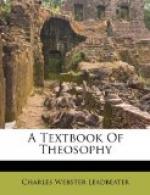A man who does not understand this usually makes one of two mistakes with regard to it: either he supposes it to be the prompting of his own nature, and therefore regards that nature as inherently evil, or he thinks of the pressure as coming from outside—as a temptation of an imaginary devil. The truth lies between the two. The pressure is natural, not to the man but to the vehicle which he is using; its desire is natural and right for it, but harmful to the man, and therefore it is necessary that he should resist it. If he does so resist, if he declines to yield himself to the feelings suggested to him, the particles within him which need those vibrations become apathetic for lack of nourishment, and eventually atrophy and fall out from his astral body, and are replaced by other particles, whose natural wave-rate is more nearly in accordance with that which the man habitually permits within his astral body.
This gives the reason for what are called promptings of the lower nature during life. If the man yields himself to them, such promptings grow stronger and stronger until at last he feels as though he could not resist them, and identifies himself with them—which is exactly what this curious half-life in the particles of the astral body wants him to do.
At the death of the physical body this vague astral consciousness is alarmed. It realizes that its existence as a separated mass is menaced, and it takes instinctive steps to defend itself and to maintain its position as long as possible. The matter of the astral body is far more fluidic than that of the physical, and this consciousness seizes upon its particles and disposes them so as to resist encroachment. It puts the grossest and densest upon the outside as a kind of shell, and arranges the others in concentric layers, so that the body as a whole may become as resistant to friction as its constitution permits, and may therefore retain its shape as long as possible.
For the man this produces various unpleasant effects. The physiology of the astral body is quite different from that of the physical; the latter acquires its information from without by means of certain organs which are specialized as the instruments of its senses, but the astral body has no separated senses in our meaning of the word. That which for the astral body corresponds to sight is the power of its molecules to respond to impacts from without, which come to them by means of similar molecules. For example, a man has within his astral body matter belonging to all the subdivisions of the astral world, and it is because of that that he is capable of “seeing” objects built of the matter of any of these subdivisions.




